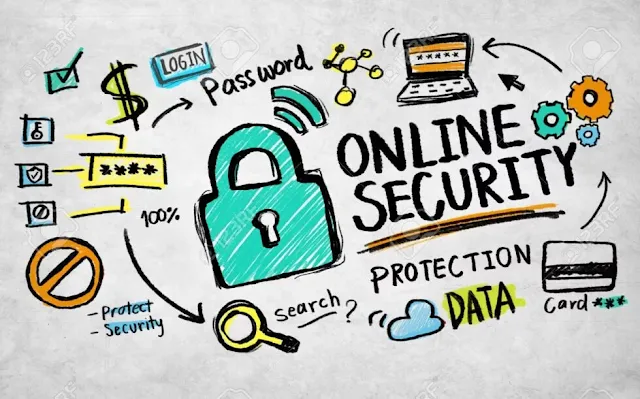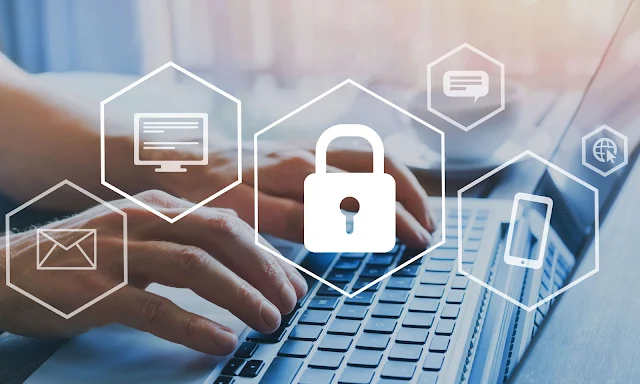Strategies to Protect Yourself from Online Risks
We live in an age where we are heavily reliant on technology, and it has become a crucial part of our daily lives. With the rise of the internet, we can shop, bank, work, and connect with people from all over the world, all at the click of a button. However, this convenience comes with risks. The online world is rife with cyber threats, such as hacking, identity theft, and phishing.
These risks pose a significant danger to our personal and financial security. The good news is that there are many strategies we can use to protect ourselves from these online threats. In this post, we'll cover some essential strategies to help you safeguard your digital fort, so you can enjoy all the benefits of technology without putting yourself at risk.
Introduction: Understanding the importance of online security
In today's interconnected world, where almost every aspect of our lives is digitized, understanding the importance of online security is paramount. The internet has revolutionized the way we communicate, work, shop, and access information, but it also exposes us to various online risks and threats.
Cybercriminals are constantly evolving their tactics, from phishing scams and malware to identity theft and data breaches. Without adequate protection measures in place, individuals and businesses alike are vulnerable to these threats, risking not only financial loss but also their privacy and reputation.
By grasping the significance of online security, you empower yourself to navigate the digital landscape with confidence and safeguard your personal and sensitive information. This introduction sets the stage for exploring effective strategies to shield your digital fort and protect yourself from the ever-present online risks.
Assessing potential online risks: Identifying common threats
Assessing potential online risks is a crucial step in safeguarding your digital presence. By identifying common threats, you can proactively develop strategies to protect yourself from these potential dangers.
Common online risks include malware and viruses that can compromise your data and system security. Phishing scams, where cybercriminals attempt to obtain sensitive information through deceptive emails or websites, are another prevalent threat.
Additionally, identity theft, unauthorized access to personal or financial information, and data breaches are significant risks that individuals and businesses face in the digital realm.
By understanding these common threats and their potential impact, you can take proactive measures to mitigate risks and enhance your online security posture. Stay informed, remain vigilant, and implement robust security measures to shield your digital fort from potential online risks.
Strong passwords and two-factor authentication: Building the first line of defense
Creating strong passwords and implementing two-factor authentication are crucial steps in fortifying your digital security. When it comes to passwords, the key is to use a unique combination of letters, numbers, and special characters that are not easily guessable. Avoid using common phrases or personal information that can be easily obtained.
Two-factor authentication adds an extra layer of security by requiring not only a password but also a second form of verification, such as a unique code sent to your mobile device. This significantly reduces the likelihood of unauthorized access even if your password is compromised.
Remember, cyber threats are constantly evolving, so it's important to regularly update your passwords and enable two-factor authentication whenever possible. By fortifying your digital defenses with strong passwords and two-factor authentication, you can significantly reduce the risk of falling victim to online attacks and safeguard your sensitive information.

Keeping software and devices updated: Patching vulnerabilities
Keeping software and devices updated is crucial in safeguarding your digital fort against online risks. Cyber attackers are constantly searching for vulnerabilities in software and devices to exploit for their malicious intents. By ensuring that your operating systems, applications, and devices are regularly updated with the latest patches and security updates, you can effectively patch these vulnerabilities and reduce the risk of being targeted.
Software vendors frequently release patches to address security flaws and enhance the overall stability of their products. These patches often contain fixes for known vulnerabilities that cybercriminals could potentially exploit to gain unauthorized access to your system or steal sensitive information. By promptly installing these updates, you not only fortify your defenses but also stay one step ahead of potential threats.
Neglecting to update software and devices leaves them susceptible to known security weaknesses, making them easy targets for cyber attacks. Hackers often exploit outdated software to infiltrate systems, install malware, or launch phishing attacks. Therefore, establishing a regular patching routine is essential to maintaining a secure digital environment and safeguarding your sensitive data from being compromised.
In addition to applying patches, it is advisable to enable automatic updates whenever possible to streamline the process and ensure that critical security updates are implemented in a timely manner. By adopting a proactive approach to patch management, you can significantly reduce the likelihood of falling victim to cyber threats and enhance the overall resilience of your digital defenses.
Securing your internet connection: Using VPNs and secure networks
Securing your internet connection is crucial in safeguarding your online activities and data from potential risks and threats. One effective strategy to achieve this is by utilizing Virtual Private Networks (VPNs) and secure networks.
A VPN creates a secure and encrypted connection between your device and the internet, ensuring that your online data remains private and protected from prying eyes. By routing your internet traffic through a remote server, VPNs mask your IP address and encrypt your data, making it difficult for hackers, advertisers, or other malicious entities to intercept your sensitive information.
In addition to VPNs, using secure networks, such as password-protected Wi-Fi networks or virtual private networks, adds an extra layer of protection to your internet connection. Avoid connecting to public Wi-Fi networks without proper security measures in place, as they are often targeted by cybercriminals looking to exploit vulnerabilities and steal sensitive data.
By incorporating VPNs and secure networks into your online security practices, you can enhance the protection of your digital fort and minimize the risks associated with browsing the internet and conducting online transactions. Stay vigilant and proactive in securing your internet connection to safeguard your privacy and maintain a safe online environment.

Being cautious with emails and links: Avoiding phishing scams
Phishing scams have become increasingly sophisticated and prevalent in today's digital landscape, making it crucial for individuals and businesses to exercise caution when dealing with emails and links. These deceptive tactics often involve fraudulent emails or messages that appear to be from legitimate sources, such as banks, social media platforms, or online retailers, in an attempt to trick recipients into revealing sensitive information or clicking on malicious links.
To shield yourself from falling victim to phishing scams, it is essential to adopt a vigilant and discerning approach. Always scrutinize the sender's email address and verify its authenticity before interacting with any links or attachments. Be wary of urgent or alarming messages that pressure you to act quickly without verifying the legitimacy of the communication.
Furthermore, avoid clicking on suspicious links embedded in emails, especially those that redirect you to unfamiliar websites requesting personal information. To enhance your defenses against phishing attempts, consider installing reputable antivirus software and email filters that can detect and block malicious content.
By cultivating a cautious mindset and practicing vigilance when engaging with emails and links, you can fortify your digital defenses and reduce the risk of falling prey to phishing scams. Remember, staying informed and proactive is key to safeguarding your online security and protecting your sensitive data from cyber threats.
Safe online shopping and banking practices: Protecting financial information
When it comes to online shopping and banking, safeguarding your financial information is paramount. In today's digital age, where cyber threats are constantly evolving, it is crucial to adopt safe practices to protect your sensitive data.
One of the first steps to ensure the security of your financial information is to only shop on secure websites. Look for the padlock symbol in the address bar and make sure the website's URL begins with "https://" indicating a secure connection.
Additionally, never share your banking details or personal information over email or text messages. Legitimate financial institutions will never ask for such information through these channels. Be cautious of phishing emails and fake websites designed to trick you into disclosing your sensitive data.
Regularly monitor your bank statements and keep track of your online transactions. Report any suspicious activity to your bank immediately. Consider setting up alerts for unusual account activity to stay informed and take quick action in case of any fraudulent transactions.
By following these safe online shopping and banking practices, you can shield yourself from online risks and protect your financial information from falling into the wrong hands. Stay vigilant and prioritize the security of your digital transactions to safeguard your financial well-being.
Social media privacy settings and data protection: Limiting exposure
In today's digital age, safeguarding your online presence is paramount to protect yourself from potential risks and threats. One crucial aspect of this is managing your social media privacy settings and ensuring robust data protection measures are in place. By limiting your exposure on social media platforms, you can control who has access to your personal information and minimize the risk of falling victim to cyber threats.
Start by reviewing and adjusting the privacy settings on all your social media accounts. Take the time to understand each platform's privacy options and customize them to suit your comfort level. Consider restricting who can view your posts, photos, and personal details to ensure that only trusted individuals have access to your information.
Furthermore, be cautious about the type of information you share online. Avoid posting sensitive details such as your address, phone number, or financial information publicly. Cybercriminals often scour social media profiles for personal data that can be exploited for fraudulent activities.
Additionally, stay informed about the data protection policies of the social media platforms you use. Regularly review their terms of service and privacy policies to understand how your data is being collected, stored, and shared. Opt-out of any unnecessary data collection practices and enable two-factor authentication for an added layer of security.

Regular data backups and encryption: Safeguarding against data loss
Regular data backups and encryption are crucial components in safeguarding against data loss and protecting your digital assets. In today's interconnected world, where cyber threats loom large, ensuring that your data is securely backed up and encrypted can provide you with peace of mind and a safety net in case of unforeseen events.
Data backups serve as a form of insurance for your valuable information. By creating regular backups of your data, you can minimize the impact of potential data loss due to hardware failure, cyberattacks, or accidental deletion. Additionally, having multiple backup copies stored in different locations can further enhance the security of your data and increase the likelihood of successful recovery in case of an emergency.
Encryption adds an extra layer of protection to your data by encoding it in a way that only authorized users with the decryption key can access it. By encrypting sensitive information, you can prevent unauthorized access and safeguard your data from prying eyes and malicious actors. Implementing encryption protocols for both data at rest and data in transit can help ensure the confidentiality and integrity of your digital assets.
Incorporating regular data backups and encryption practices into your digital security strategy can significantly reduce the risks of data loss and unauthorized access, allowing you to fortify your digital fort and shield yourself against online threats. By prioritizing data protection measures, you can proactively safeguard your information and maintain the resilience of your digital infrastructure in an increasingly digital world.
Conclusion: Taking proactive steps to shield your digital presence
In conclusion, safeguarding your digital presence is crucial in today's interconnected world. By implementing proactive strategies and staying vigilant, you can significantly reduce the risks associated with online threats.
Remember, maintaining strong and unique passwords, enabling two-factor authentication, keeping your software updated, and being cautious of suspicious links and emails are fundamental steps in fortifying your digital defenses.
Furthermore, educating yourself and your team on cybersecurity best practices, conducting regular security audits, and investing in reliable security solutions are essential components of a robust defense strategy.
By prioritizing the protection of your digital assets and personal information, you not only safeguard your online presence but also contribute to a safer and more secure digital ecosystem for everyone.
Stay informed, stay proactive, and stay secure. Together, we can fortify our digital fortresses and navigate the online landscape with confidence and resilience.
Finally
In the digital age, protecting your online presence is paramount to safeguarding your personal and professional information. We have shared valuable strategies in this blog to help you fortify your digital defenses and shield yourself from online risks. By implementing these proactive measures, you can navigate the digital landscape with confidence and peace of mind. Stay vigilant, stay informed, and stay protected in the ever-evolving realm of cyberspace.





.jpeg)

